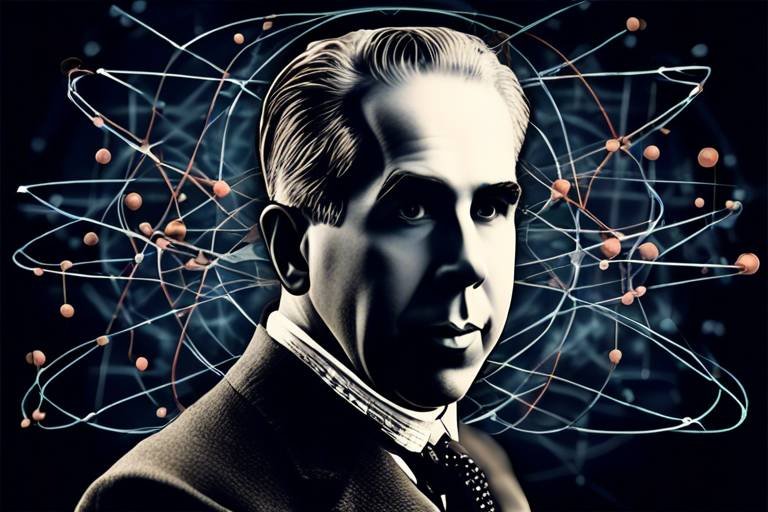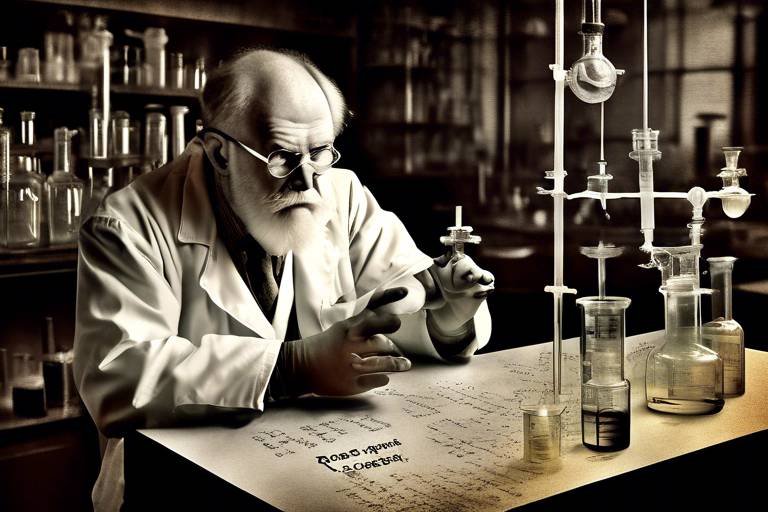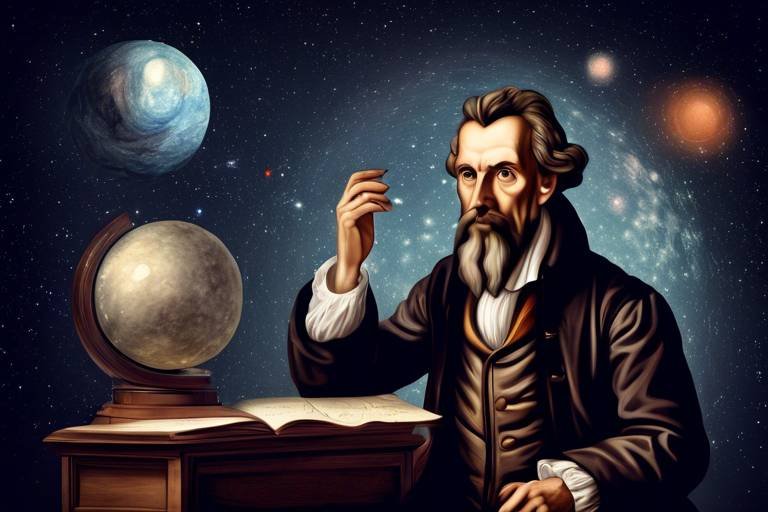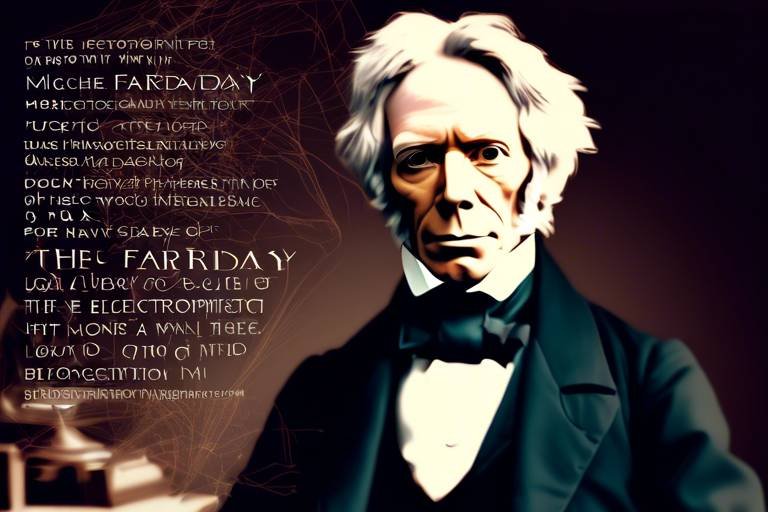The Life of Antonie van Leeuwenhoek and the Microscope
Antonie van Leeuwenhoek, often hailed as the father of microbiology, embarked on a journey that would forever change our understanding of the microscopic world. Born in 1632 in Delft, Netherlands, his life was a tapestry woven from curiosity, craftsmanship, and an insatiable desire for knowledge. Imagine living in a time when the very existence of microscopic life was a mystery; that was the world Leeuwenhoek navigated. He wasn't just a scientist; he was a pioneer, a visionary who saw beyond the naked eye. His groundbreaking work with the microscope opened the door to a universe teeming with life, fundamentally altering the course of science.
Leeuwenhoek's early years were marked by modest beginnings. Growing up in a middle-class family, he was the son of a basket maker. Despite his lack of formal education, his innate curiosity set him apart. He apprenticed as a fabric merchant, which not only honed his business acumen but also nurtured his observational skills. It's fascinating to think that while he was measuring cloth, he was also measuring the world around him, developing a keen eye for detail. This period of his life was crucial; it shaped his future endeavors in science. His education was unconventional, relying more on hands-on experiences and self-directed learning than traditional schooling. This blend of craftsmanship and curiosity laid the groundwork for his future discoveries.
Before diving into the world of science, Leeuwenhoek spent years as a merchant. His travels across Europe exposed him to diverse cultures and ideas, sparking a fascination with the natural world. Picture a young merchant, navigating bustling markets and engaging with people from all walks of life. Each encounter added a new layer to his understanding of nature. This exposure ignited a passion for observation, leading him to explore the microscopic world. His merchant career was not just about trade; it was a stepping stone that allowed him to cultivate his skills in observation and experimentation.
Leeuwenhoek's foray into lens-making was nothing short of revolutionary. He crafted microscopes with unparalleled precision, achieving magnifications that had never been seen before. His lenses were simple yet effective, allowing him to peer into a world invisible to the naked eye. Imagine looking through a tiny glass lens and suddenly seeing a universe filled with vibrant microorganisms! His designs were groundbreaking, enabling him to observe and document life at a microscopic level. Leeuwenhoek's microscopes were not merely tools; they were gateways to discovery, transforming the way we understand biology.
Through his innovative microscopes, Leeuwenhoek made astonishing discoveries that would lay the foundation for microbiology. He was the first to observe and describe bacteria, protozoa, and spermatozoa, unveiling a hidden world that was previously unknown. His meticulous observations were recorded in detailed letters, showcasing his dedication to science. Each discovery was like a piece of a puzzle, revealing the complexity of life. Leeuwenhoek's work challenged existing beliefs and opened new avenues for scientific inquiry, inspiring future generations to explore the microscopic realm.
Leeuwenhoek's communication with the Royal Society in London was pivotal in sharing his groundbreaking findings. His letters, filled with detailed accounts of his observations, garnered respect and recognition from fellow scientists. Imagine receiving a letter that describes a tiny creature swimming in a drop of water—how thrilling that must have been! His correspondence not only validated his work but also connected him with the scientific community, allowing his discoveries to ripple through the world of science.
The impact of Leeuwenhoek's work on microbiology cannot be overstated. He challenged the prevailing notions of his time and inspired a wave of scientific exploration. His discoveries prompted questions about health, disease, and the very nature of life itself. The microscopic world he unveiled became a new frontier for scientists, paving the way for advancements in medicine and biology. Leeuwenhoek's legacy is a testament to the power of curiosity and observation, reminding us that the smallest things can have the most profound effects.
Despite his humble beginnings, Leeuwenhoek's contributions to science earned him a lasting legacy. He is celebrated as a pioneer in microbiology, and his name remains synonymous with the discovery of the microscopic world. His work laid the groundwork for future scientists, and he is remembered not just for his discoveries but for his relentless pursuit of knowledge. Today, we honor him as a symbol of curiosity and innovation, proving that anyone, regardless of their background, can make a significant impact on the world.
The principles established by Leeuwenhoek continue to resonate in modern science. His techniques and discoveries laid the groundwork for advancements in various fields, including medicine, biology, and technology. Today, we use sophisticated microscopes to explore the microscopic world, building on the foundation he created. His legacy lives on in countless applications, from medical research to biotechnology, illustrating how one man's curiosity can shape the future of science.
- What did Antonie van Leeuwenhoek discover? Leeuwenhoek discovered bacteria, protozoa, and spermatozoa, among other microscopic organisms.
- How did Leeuwenhoek make his microscopes? He crafted his microscopes using handmade lenses, achieving remarkable magnification.
- Why is Leeuwenhoek called the father of microbiology? His pioneering work in observing and documenting microscopic life laid the foundation for the field of microbiology.
- What was Leeuwenhoek's profession before becoming a scientist? He worked as a merchant, which helped him develop his observational skills.

Early Life and Education
Antonie van Leeuwenhoek was born on October 24, 1632, in the charming city of Delft, Netherlands. Coming from a modest background, he was the son of a basket maker, which meant that financial resources were limited, yet this did not stifle his innate curiosity. Despite the lack of formal education, Leeuwenhoek's early years were marked by a voracious appetite for learning. He was an observant child, often captivated by the world around him, which laid the groundwork for his future scientific endeavors.
Leeuwenhoek's education was largely informal, consisting of self-directed study and hands-on experience. He apprenticed as a fabric merchant at a young age, which allowed him to travel and see the world beyond Delft. This exposure to different cultures and ideas ignited a spark in him, pushing him to delve deeper into the mysteries of nature. While he may not have attended a prestigious university, his relentless quest for knowledge was evident as he began to explore the natural sciences on his own.
In his quest for understanding, Leeuwenhoek became fascinated with lenses and optics. He started experimenting with glass, crafting his own lenses that would eventually lead to the invention of the microscope. His passion for craftsmanship and keen observational skills were critical in shaping his scientific journey. The combination of his early experiences in trade and his relentless curiosity about the natural world created a unique foundation for his groundbreaking work in microbiology.
Leeuwenhoek’s lack of formal education did not deter him; instead, it fueled his determination to prove that anyone, regardless of their background, could contribute to science. He often said, “I am a simple man,” but his simple beginnings belied the profound impact he would have on the scientific community. His life serves as a reminder that curiosity and perseverance can lead to extraordinary discoveries.

Career as a Merchant
Before Antonie van Leeuwenhoek became the renowned scientist we celebrate today, he embarked on a career as a merchant in the bustling city of Delft. This phase of his life was not merely a means to earn a living; it was a journey that would significantly shape his future discoveries. Leeuwenhoek's role as a merchant allowed him to travel extensively, engaging with diverse cultures and ideas. Imagine the vibrant markets he wandered through, filled with exotic goods and the lively chatter of traders from distant lands. It was here, amidst the hustle and bustle, that his curiosity about the natural world began to flourish.
As a merchant, Leeuwenhoek dealt primarily in cloth, but his keen eye was drawn to more than just fabrics. He developed a knack for observation that would later prove invaluable in his scientific pursuits. His interactions with various merchants and craftsmen ignited a passion for understanding the intricacies of the world around him. This period was crucial; it was like laying the foundation for a grand building—the stronger the base, the higher it could rise. Each interaction and experience added to his knowledge and perspective, ultimately leading him to explore the microscopic world.
Leeuwenhoek's travels introduced him to new ideas and innovations, particularly in the realm of craftsmanship. He became fascinated by the art of lens-making, which would later play a pivotal role in his scientific achievements. His merchant career was not just about trading goods; it was a gateway to the scientific community. He learned the importance of precision and quality, lessons that he would carry into his future endeavors as a scientist. In fact, the meticulous nature required in trade mirrored the precision he would later apply in his microscopic observations.
Moreover, Leeuwenhoek's experiences as a merchant cultivated his ability to communicate effectively. He learned to articulate his observations and findings clearly—a skill that would prove essential when he began sharing his groundbreaking discoveries with the scientific community. Just as a merchant must persuade customers of the value of their wares, Leeuwenhoek had to convince fellow scientists of the significance of his microscopic discoveries. His letters to the Royal Society, filled with detailed accounts of his observations, were akin to a merchant showcasing their finest products, designed to captivate and inform.
In summary, Antonie van Leeuwenhoek's career as a merchant was more than a simple occupation; it was a formative experience that laid the groundwork for his future as the father of microbiology. His travels, observations, and interactions enriched his understanding of the world, ultimately leading him to explore and unveil the mysteries of the microscopic realm. The skills he honed as a merchant—observation, precision, and communication—became the cornerstones of his scientific legacy.

Invention of the Microscope
This article explores the remarkable life of Antonie van Leeuwenhoek, the father of microbiology, and his groundbreaking work with the microscope, which revolutionized our understanding of the microscopic world.
Antonie van Leeuwenhoek's formative years in Delft shaped his curiosity and skills. His humble beginnings and lack of formal education did not hinder his pursuit of knowledge in science and craftsmanship.
Before becoming a scientist, Leeuwenhoek worked as a merchant, which allowed him to travel and interact with various cultures. His experiences in trade sparked his interest in the natural world and observation.
Antonie van Leeuwenhoek's journey into the world of microscopy began with a simple fascination with lenses. While many of his contemporaries were content with the rudimentary microscopes of the time, Leeuwenhoek took it upon himself to innovate. He meticulously crafted his own lenses, achieving a level of magnification that was previously unimaginable. Imagine being able to look at a drop of water and see a bustling city of tiny organisms swimming around—this was the reality Leeuwenhoek created.
Leeuwenhoek's microscopes were not just ordinary instruments; they were masterpieces of craftsmanship. He used a method known as single-lens microscopy, which involved a single, powerful lens mounted in a frame. This design was revolutionary because it allowed for much higher magnification than the compound microscopes that were common at the time. His most effective lenses could magnify objects up to 300 times their original size, revealing a world that was invisible to the naked eye.
To give you an idea of how groundbreaking his work was, consider the following table that compares traditional microscopes of the era with Leeuwenhoek's creations:
| Feature | Traditional Microscopes | Leeuwenhoek's Microscopes |
|---|---|---|
| Type of Lens | Compound Lenses | Single Lens |
| Maximum Magnification | Up to 50x | Up to 300x |
| Field of View | Limited | Wide and Detailed |
| Portability | Bulky | Compact and Easy to Use |
His passion for observation did not stop at just creating the microscopes; he was relentless in his quest for discovery. Leeuwenhoek began to observe a variety of samples, from pond water to dental scrapings, and what he found was astonishing. He documented his findings with an attention to detail that was unprecedented for his time. The meticulous nature of his work, combined with his innovative lens-making skills, made him a pioneer in the field of microscopy.
In essence, Leeuwenhoek's invention of the microscope was not just about the tool itself; it was about opening a door to a new world. His work laid the foundation for microbiology, inspiring generations of scientists to explore the unseen realms of life. It's as if he handed us a pair of glasses that allowed us to see a vibrant universe teeming with life, forever changing our understanding of biology and the natural world.
Through his microscopes, Leeuwenhoek made groundbreaking discoveries, including bacteria, protozoa, and spermatozoa. His meticulous observations laid the foundation for microbiology and advanced the scientific community's understanding of life.
Leeuwenhoek's communication with the Royal Society in London played a crucial role in disseminating his findings. His letters provided detailed accounts of his observations, garnering recognition and respect from fellow scientists.
Leeuwenhoek's work significantly influenced the field of microbiology. His discoveries challenged existing beliefs and inspired future generations of scientists to explore the microscopic realm and its implications for health and disease.
Despite his humble beginnings, Leeuwenhoek's contributions to science earned him a lasting legacy. He is celebrated as a pioneer in microbiology, and his name remains synonymous with the discovery of the microscopic world.
The principles established by Leeuwenhoek continue to impact modern science. His techniques and discoveries laid the groundwork for advancements in medicine, biology, and technology, influencing countless fields today.
- What was Antonie van Leeuwenhoek's main contribution to science?
Leeuwenhoek is best known for his pioneering work in microscopy, where he discovered microorganisms and laid the groundwork for microbiology. - How did Leeuwenhoek make his microscopes?
He crafted his own lenses, focusing on single-lens designs that allowed for much higher magnification than the compound microscopes of his time. - Why is Leeuwenhoek considered the father of microbiology?
His meticulous observations and discoveries of microscopic life forms fundamentally changed our understanding of biology and the natural world.

Scientific Discoveries
Through his remarkable microscopes, Antonie van Leeuwenhoek opened a whole new world of discovery that had previously been invisible to the naked eye. Imagine peering into a universe teeming with life, where tiny organisms danced and interacted in ways that were utterly unknown to mankind until his time. Leeuwenhoek was not just a curious observer; he was a pioneer who documented his findings with meticulous attention to detail. His observations led to the identification of various microscopic entities that revolutionized the field of biology.
One of his most significant discoveries was that of bacteria. In 1676, while examining a sample of dental plaque, he noticed tiny, single-celled organisms that would later be classified as bacteria. This was a groundbreaking moment, as it challenged the prevailing notions of spontaneous generation and laid the groundwork for future microbiological research. Leeuwenhoek's observations were not merely casual glances; they were thorough investigations that provided insights into the structure and behavior of these microorganisms.
In addition to bacteria, Leeuwenhoek also discovered protozoa, which he referred to as "animalcules." These microscopic creatures were found in various samples, including pond water and even his own bodily fluids. His detailed sketches and descriptions of these organisms showcased his exceptional observational skills. He described their movements and behaviors, noting how they swam with a grace that was both fascinating and bewildering. This was a time when the very concept of microscopic life was foreign to most, and Leeuwenhoek's work was like a window into a hidden world.
Moreover, Leeuwenhoek's investigations extended to the realm of human reproduction. He was the first to observe spermatozoa, the male reproductive cells, in 1677. His discovery of these tiny, motile cells was groundbreaking, as it provided a new understanding of human biology and reproduction. Leeuwenhoek's observations challenged existing beliefs about the origins of life and contributed significantly to the field of reproductive biology.
To put his discoveries into context, consider the following table that summarizes some of his key findings:
| Discovery | Year | Description |
|---|---|---|
| Bacteria | 1676 | First observation of single-celled organisms in dental plaque. |
| Protozoa | 1674 | Described various microscopic creatures found in water. |
| Spermatozoa | 1677 | First observation of male reproductive cells in human semen. |
Leeuwenhoek's meticulous documentation of his findings, paired with his innovative lens-making techniques, allowed him to achieve magnifications that were previously unimaginable. His work not only expanded the scientific community's understanding of life but also laid the foundation for future microbiologists who would build upon his discoveries. This was a time when science was just beginning to embrace the idea of exploration at the microscopic level, and Leeuwenhoek was at the forefront of this revolution.
In conclusion, Antonie van Leeuwenhoek's scientific discoveries were nothing short of revolutionary. He unlocked the secrets of the microscopic world, revealing a complex and vibrant universe that forever changed our understanding of biology. His legacy continues to inspire scientists today, as we delve deeper into the mysteries of life that he first uncovered.
- What is Antonie van Leeuwenhoek best known for?
He is best known for his pioneering work in microbiology and for being the first to observe and describe microorganisms using a microscope. - How did Leeuwenhoek make his microscopes?
Leeuwenhoek crafted his microscopes using high-quality glass lenses, which he made by hand, allowing for unprecedented magnification. - What impact did his discoveries have on science?
His discoveries challenged existing scientific beliefs, laid the groundwork for microbiology, and inspired future generations of scientists.

Correspondence with the Royal Society
Antonie van Leeuwenhoek's relationship with the Royal Society in London was a pivotal chapter in his life and scientific career. Imagine a humble merchant from Delft, a man with no formal education, suddenly finding himself at the center of the scientific revolution! Through his keen observations and groundbreaking discoveries, Leeuwenhoek managed to capture the attention of some of the most prominent scientists of his time.
In 1673, he sent his first letter to the Royal Society, detailing his observations of microscopic organisms. This letter was not just a simple note; it was a window into a world that had previously been invisible to the naked eye. His meticulous descriptions of tiny creatures, such as bacteria and protozoa, were so compelling that they sparked a wave of interest among the members of the Society. Leeuwenhoek's letters were filled with enthusiasm and wonder, as he shared his findings in a way that was both informative and engaging.
Over the years, Leeuwenhoek continued to correspond with the Royal Society, sending numerous letters that detailed his observations and experiments. His communication style was unique; he wrote with a sense of excitement that made his discoveries come alive. Each letter not only described his findings but also included drawings of the organisms he observed, which added a visual dimension to his work. These illustrations became a vital part of his correspondence, allowing readers to visualize the microscopic world he was uncovering.
The impact of Leeuwenhoek's correspondence with the Royal Society cannot be overstated. His letters served as a bridge between his discoveries and the scientific community, helping to disseminate knowledge that would eventually change the course of biology. The Society recognized his contributions, and he became a fellow in 1680, marking a significant acknowledgment of his work.
In a time when science was still in its infancy, Leeuwenhoek's ability to communicate complex ideas in a straightforward manner set him apart. His correspondence not only educated his contemporaries but also laid the groundwork for future scientific discourse. The Royal Society became a platform for Leeuwenhoek's ideas, and through it, he garnered respect and admiration from fellow scientists. His findings challenged existing beliefs and encouraged others to explore the microscopic world.
Today, Leeuwenhoek's letters are regarded as historical treasures, showcasing the early days of microbiology. They remind us of a time when curiosity and observation led to remarkable discoveries, and they continue to inspire scientists and enthusiasts alike. The legacy of Antonie van Leeuwenhoek is not just in his discoveries but also in the way he communicated them to the world, forever changing our understanding of life itself.
- What did Leeuwenhoek discover? Antonie van Leeuwenhoek discovered several microscopic organisms, including bacteria, protozoa, and spermatozoa, through his innovative microscope designs.
- How did Leeuwenhoek communicate his findings? He corresponded with the Royal Society in London, sending detailed letters that described his observations and included illustrations of the organisms he studied.
- Why is Leeuwenhoek considered the father of microbiology? His pioneering work with microscopes and his meticulous observations laid the foundation for the field of microbiology, earning him this title.
- What was the significance of Leeuwenhoek's letters? His letters helped disseminate knowledge about the microscopic world, influencing the scientific community and challenging existing beliefs.

Impact on Microbiology
Antonie van Leeuwenhoek's contributions to the field of microbiology were nothing short of revolutionary. Before his time, the microscopic world was largely a mystery, hidden from human eyes and understanding. With his remarkable microscopes, Leeuwenhoek brought this hidden universe into the light, revealing a plethora of microscopic organisms that were previously unknown. His discoveries not only challenged the scientific community's existing beliefs but also opened up new avenues for research and exploration.
Leeuwenhoek's meticulous observations led to the identification of various microorganisms, including bacteria and protozoa. He was the first to document these tiny life forms, which fundamentally altered our understanding of biology. Imagine being the first person to look through a window into a world that had been invisible to everyone else! This was the reality for Leeuwenhoek, and his findings laid the groundwork for what would eventually become the field of microbiology.
His work had significant implications for several areas of science and medicine. For instance, the discovery of bacteria prompted further investigation into their role in disease, hygiene, and fermentation. Leeuwenhoek's observations not only sparked curiosity but also led to practical applications in health and industry. The realization that microorganisms could be both beneficial and harmful paved the way for advancements in fields such as:
- Medicine: Understanding pathogens and the importance of sanitation.
- Food Science: The role of bacteria in fermentation and spoilage.
- Environmental Science: The impact of microorganisms on ecosystems.
Moreover, Leeuwenhoek's correspondence with the Royal Society in London helped disseminate his findings far and wide. His letters, filled with detailed observations, not only provided validation for his work but also inspired others to delve into the microscopic world. This exchange of knowledge was crucial in establishing a scientific community that valued observation and empirical evidence, setting the stage for future microbiologists.
In essence, Leeuwenhoek transformed the study of life by introducing a new dimension to biological research. His work laid the foundation for future scientists, such as Louis Pasteur and Robert Koch, who would build upon his discoveries to develop the germ theory of disease. This theory fundamentally changed our understanding of infectious diseases and how they spread, ultimately leading to modern practices in medicine and public health.
As we reflect on Leeuwenhoek's impact on microbiology, it becomes clear that his legacy is not merely about the discoveries he made but also about the curiosity he ignited in others. His passion for observation and inquiry continues to inspire scientists today, reminding us of the importance of looking closely at the world around us. In a way, Leeuwenhoek opened the door to a new realm of possibilities, inviting future generations to explore the unseen and challenge the known.
Q1: What did Antonie van Leeuwenhoek discover?
A1: Leeuwenhoek discovered various microorganisms, including bacteria, protozoa, and spermatozoa, through his innovative microscope designs.
Q2: Why is Leeuwenhoek considered the father of microbiology?
A2: He is considered the father of microbiology because he was the first to observe and document microscopic life forms, laying the groundwork for the field.
Q3: How did Leeuwenhoek's work influence modern science?
A3: His discoveries challenged existing scientific beliefs and inspired further research, leading to advancements in medicine, biology, and technology.
Q4: What role did Leeuwenhoek's correspondence with the Royal Society play?
A4: His correspondence helped disseminate his findings to a broader audience, gaining him recognition and encouraging others to explore microscopy.

Legacy and Recognition
Antonie van Leeuwenhoek's legacy is as profound as it is enduring. Despite his humble beginnings, this remarkable man carved out a place in the annals of science that few can rival. Often referred to as the father of microbiology, his pioneering work with the microscope opened the door to a previously unseen world, fundamentally altering our understanding of life itself. Imagine a time when the very existence of microorganisms was unknown; Leeuwenhoek not only discovered them but also meticulously documented his findings, laying the groundwork for future scientific inquiry.
His contributions did not go unnoticed. Leeuwenhoek's meticulous observations and innovative techniques earned him the respect of many contemporaries. He became a member of the prestigious Royal Society of London, a testament to his significant impact on the scientific community. His letters to the Society, filled with detailed descriptions of his microscopic observations, were groundbreaking. They provided insights that challenged existing scientific paradigms and inspired a wave of curiosity and exploration among his peers.
Moreover, Leeuwenhoek's work has had a lasting influence that extends far beyond his lifetime. The principles he established in microscopy are still foundational in modern science. Today, we utilize advanced microscopes that owe their existence to Leeuwenhoek's early designs. His discoveries paved the way for advancements in various fields, including medicine, biology, and technology. The understanding of diseases, the development of vaccines, and even the exploration of genetic material can trace their roots back to the curiosity and ingenuity of this one man.
In recognition of his contributions, numerous honors have been bestowed upon him posthumously. Various scientific institutions and awards have been named in his honor, ensuring that his name will forever be associated with the discovery of the microscopic world. For instance, the Antonie van Leeuwenhoek Medal is awarded to individuals who have made significant contributions to microbiology, keeping his spirit of innovation alive in the scientific community.
To sum it up, Antonie van Leeuwenhoek's legacy is not just about his discoveries; it's about the way he transformed our understanding of life. He taught us that there is a whole universe teeming with life that is invisible to the naked eye, and his relentless pursuit of knowledge continues to inspire scientists around the globe. His story is a reminder of how one person's curiosity can lead to monumental shifts in our understanding of the world.
- What did Antonie van Leeuwenhoek discover?
He discovered microorganisms, including bacteria, protozoa, and spermatozoa, using his handcrafted microscopes. - How did Leeuwenhoek's work influence modern science?
His techniques in microscopy laid the groundwork for microbiology, influencing advancements in medicine and biology. - Was Leeuwenhoek recognized during his lifetime?
Yes, he was recognized by the Royal Society of London and became a respected figure in the scientific community. - What is the Antonie van Leeuwenhoek Medal?
This award is given to individuals who have made significant contributions to the field of microbiology.

Modern Applications of His Work
Antonie van Leeuwenhoek's groundbreaking work with the microscope has had a profound and lasting impact on modern science. His innovative lens-making techniques and meticulous observations paved the way for numerous applications that we still rely on today. Imagine a world where we couldn't see the tiniest organisms that inhabit our planet—Leeuwenhoek opened the door to a hidden universe that has transformed our understanding of biology, medicine, and technology.
One of the most significant applications of Leeuwenhoek's work is in the field of microbiology. His discovery of microorganisms such as bacteria and protozoa laid the foundation for the entire discipline. Today, microbiology plays a crucial role in various industries, including healthcare, agriculture, and environmental science. For instance, understanding bacterial pathogens has led to the development of antibiotics, vaccines, and hygiene practices that save millions of lives each year.
Furthermore, Leeuwenhoek's techniques have influenced the way we approach medical diagnostics. The ability to observe and identify microorganisms has revolutionized how we diagnose diseases. Modern laboratories use advanced microscopy techniques, including electron microscopy, to detect pathogens in blood, tissue, and other samples. This rapid and precise identification is essential for effective treatment and control of infectious diseases.
In addition to healthcare, Leeuwenhoek's contributions extend to the field of biotechnology. His work has inspired genetic engineering and synthetic biology, where scientists manipulate microorganisms to produce valuable substances. For example, bacteria are now used to manufacture insulin, enzymes, and biofuels. This application not only demonstrates the versatility of microorganisms but also highlights the importance of Leeuwenhoek's initial discoveries.
Moreover, his influence reaches into the realm of environmental science. Understanding microbial ecosystems is crucial for maintaining ecological balance and addressing environmental challenges. Microorganisms play vital roles in nutrient cycling, waste decomposition, and bioremediation. By studying these tiny organisms, scientists can develop strategies to combat pollution and restore ecosystems, showcasing the relevance of Leeuwenhoek's work even today.
In summary, the principles established by Antonie van Leeuwenhoek continue to resonate throughout modern science. His pioneering work not only opened our eyes to the microscopic world but also provided the tools and knowledge necessary to explore it further. As we advance in technology and understanding, we owe a great debt to Leeuwenhoek for laying the groundwork that enables us to tackle some of the most pressing challenges of our time.
- What did Antonie van Leeuwenhoek discover?
Leeuwenhoek is renowned for discovering microorganisms, including bacteria, protozoa, and spermatozoa, through his innovative microscopes.
- How did Leeuwenhoek contribute to microbiology?
His meticulous observations and documentation of microscopic life laid the foundation for the field of microbiology, influencing countless scientists after him.
- What modern applications stem from Leeuwenhoek's work?
His discoveries have impacted healthcare, biotechnology, and environmental science, leading to advancements in diagnostics, disease treatment, and ecological restoration.
- Why is Leeuwenhoek often referred to as the "father of microbiology"?
His pioneering work in observing and documenting microscopic organisms established the groundwork for microbiology as a scientific discipline.
Frequently Asked Questions
- Who was Antonie van Leeuwenhoek?
Antonie van Leeuwenhoek was a Dutch scientist known as the father of microbiology. He was the first to observe and describe microorganisms using a microscope he designed himself. His work laid the foundation for the field of microbiology and advanced our understanding of the microscopic world.
- What did Antonie van Leeuwenhoek invent?
Leeuwenhoek is credited with inventing a powerful microscope that could magnify objects up to 300 times. His innovative lens-making techniques allowed for unprecedented observations of tiny organisms, such as bacteria and protozoa, which had never been seen before.
- How did Leeuwenhoek contribute to science?
Through his meticulous observations, Leeuwenhoek discovered various microscopic entities, including bacteria, spermatozoa, and protozoa. His detailed correspondence with the Royal Society helped disseminate his findings, earning him recognition and respect in the scientific community.
- What impact did Leeuwenhoek's work have on microbiology?
Leeuwenhoek's discoveries challenged existing scientific beliefs and opened new avenues for research in microbiology. His work inspired future generations of scientists to explore the microscopic realm, leading to significant advancements in health, disease understanding, and biological sciences.
- Did Leeuwenhoek receive formal education?
No, Antonie van Leeuwenhoek did not have formal scientific education. He was largely self-taught, driven by a curiosity for the natural world and a passion for craftsmanship, which ultimately led to his groundbreaking discoveries.
- What legacy did Antonie van Leeuwenhoek leave behind?
Leeuwenhoek's legacy is profound; he is celebrated as a pioneer in microbiology. His contributions not only changed the scientific landscape of his time but also continue to influence modern science, medicine, and technology.
- How do Leeuwenhoek's discoveries apply to modern science?
The principles established by Leeuwenhoek are foundational to modern biology and medicine. His techniques in microscopy paved the way for advancements in various fields, including microbiology, immunology, and biotechnology, impacting how we understand and treat diseases today.



















